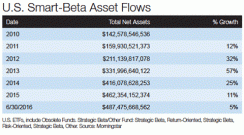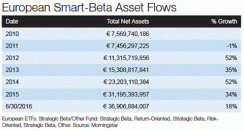To view a PDF of the report, click here.
As more investors adopt smart beta, scrutiny is intensifying—not only of factor and style investing, but also of the fine points of portfolio and index construction.
From a few brave early adopters after the 2008 financial crisis, use of the investment strategies now known as smart beta has grown dramatically. And they are becoming mainstream. Growth over the past year alone hit 7.1 percent as stable-value assets under management globally reached a record $429 billion (see ”Volatility drives growth” below). “AUM in funds tracking our indices has grown by about 50 percent year-to-date over all of last year,” says Eric Shirbini, global product specialist at Scientific Beta—a pace he expects will continue. “Our pipeline is just as strong as last year.”
Smart-beta vehicles consist of non-market-cap-weighted indexes, usually tilted toward recognized investment factors and styles such as low volatility, quality, value and momentum. Year to date, investors have been especially attracted to funds that attempt to minimize volatility. “We have seen the acceleration of this trend as uncertainty has increased around the Brexit consequences and the question of overall growth in Europe,” says Marlene Hassine, head of ETF research at Lyxor Asset Management. Mindful of the low-yield environment, however, investors are also looking for alternative sources of return such as high-dividend strategies.
Factor and style investing are alternatives to active management and hedge funds for investors who want to get exposure to good, long-term sources of return. “As investors look at these alternative means of accessing these return sources, they are changing the way they build their portfolios,” says Ronen Israel, principal and portfolio manager at AQR. Fees are part of the equation as well and investors are also looking for more transparency. “This leads to a better understanding of exactly what they’re investing in and it also enables them to compare and differentiate the many products available,” Israel says.
A look under the hood
For investors, the past five years have been a period of implementation and familiarization with smart beta’s characteristics and how it works. Product proliferation means investors must be more diligent about making sure they understand exactly what they are buying. “We’ve reached the point in the development of smart beta where people are really taking a closer look at some of these issues and seeing how construction techniques make a difference,” says Jennifer Bender, director of research for the Global Equity Beta Solutions group at SSGA.
Until recently, few investors gave much thought to how index construction techniques actually affect outcomes; today, more are taking a closer look under the hood. “The strategies can have similar names, but when you look closely, they have vastly different approaches,” says John Feyerer, director of equity ETF product strategy at Powershares. For example, there are two common ways to implement an index-based low-volatility strategy. One is simply to rank and weight stocks from a given universe based on their realized volatility. The other is optimized and constrained in a way that provides more direct exposure to the value factor. “These stark differences can be misunderstood,” Feyerer says.
Multifactor portfolio construction can become much more complex. There are two basic approaches. In the combination method, one first creates single-factor portfolios, then combines them; in the bottom-up or integrated approach, one creates an aggregate score for each stock across all the desired factors, then assigns weights.
Scientific Beta uses the combination method. “We build our single factor portfolios first,” says Shirbini. The firm selects half the stocks from the broad universe that have the highest exposure to a particular factor, applying a multi-strategy weighting scheme to avoid concentrations and other unintended risks. The higher the concentration in certain sectors or companies, the more idiosyncratic risk will work its way in.
For example, many value indexes overweighted Volkswagen, which worked against them when the automaker was exposed as having used software in 11 million of its vehicles that cheated on emissions tests. “That is exactly what we want to avoid by diversifying across all of the value stocks,” says Shirbini. Scientific Beta then combines the size, value, low volatility, high profitability and momentum indexes that make up its multifactor index by allocating equally to each. “When one factor does poorly another one may compensate,” he says. It’s worked, as the multifactor index has outperformed the MSCI World Index by 3.3 percent per year.
SSGA, by contrast, uses the bottom-up approach. “We take each individual stock and assign it a score for each of the factors we’re trying to capture,” says Bender. “If you’re interested in capturing more than one factor, it makes sense to weight the stock based on how that stock ranks on, for example, value, momentum and quality at the same time,” she says. Otherwise one could miss out on the interaction effects. In a comparison of single-factor portfolios blended in combination versus a bottom-up portfolio built by considering all the factors simultaneously, SSGA found the bottom-up approach results in a higher annualized rate of return with lower volatility.
Some say the bottom-up multifactor portfolio is indeed the most efficient because the strategy avoids buying or selling securities at the same time. “You can also manage overall exposures collectively with more efficiency and transparency than if you simply buy individual factor funds and shift the weights around,” says Jeremy Baskin, Global CEO and CIO of Rosenberg Equities, a unit of AXA Investment Managers. “But you have to be wary of a few things.”
For example, there was a time in 2009 when the correlation between momentum and value was almost -0.9, and there were few stocks that scored favorably on both factors. “If you weighted only those stocks that had the highest combined score, you would end up with very mediocre exposures on both dimensions,” Baskin says.
AQR takes the bottom-up, or integrated, approach a step further. “Integrated” means using multiple factors or styles simultaneously in a single portfolio by selecting the securities that look best across all the factors taken together. “It’s the most efficient way to capture those exposures and it leads to better portfolios over time,” says Israel.


The strategy can also go long and short. “Long-short can more fully capture the underlying themes because it is a purer representation of the desired exposures,” says Israel. It’s also uncorrelated to a traditional portfolio, because the primary risk is no longer the equity market but the relative performance of the styles and factors. Finally, the concept can be applied to other asset classes, including those that do not rely on a benchmark, like fixed income, currencies and commodities, resulting in a multi-style, multi-asset-class, long-short framework. “At this point you have a more efficient representation of these returns and one that is more diversifying,” says Israel.
The sheer number of smart beta products can make selection confusing. “As you move toward the increasingly complex end of the multifactor spectrum, you start to move away from the beta in smart beta,” says Feyerer. These more complex methodologies tend to require more judgment and reliance on rules-based, quantitative strategies. “There is a place for those,” he says. Investors simply need to know the difference.
Passive is the new active
Discretionary active smart beta is a new approach to factor allocation that calls for diversifying a portfolio across multiple factors to generate strong risk-adjusted returns in the long run. “But if you have the skill to navigate a volatile market or macroeconomic environment, you might also adjust the factor exposures to what is forecast to perform best,” says Laurent Trottier, global head of ETF, indexing and smart beta management at Amundi. In a bear market, for example, low volatility and high dividend strategies could provide downside protection and outperformance, while strategies based on value, momentum and size could enhance returns in a bull market.
Rising allocations to smart beta suggest that many investors are beginning to recognize what research has proven all along: Most of active managers’ performance comes from the ability to gain factor exposure. “So you can use the principles of smart beta in an active way,” says Guillaume Lasserre, head of active investment strategies at Lyxor. “We’re not talking about stock picking any more, but the dynamic management of factor exposures.” This means using systematic factor investing techniques, but adding a layer of qualitative judgment based on a view of the market environment.
| Volatility drives growth
Year to date, smart-beta products have seen global net inflows of $16.15 billion. Morningstar reported asset flows to U.S. smart-beta ETFs growing 11 percent in 2015 and 5 percent year-to-date at the end of June. Asset flow growth among European smart-beta ETFs has been even more rapid, hitting 34 percent in 2015 and 18 percent year-to-date. |





